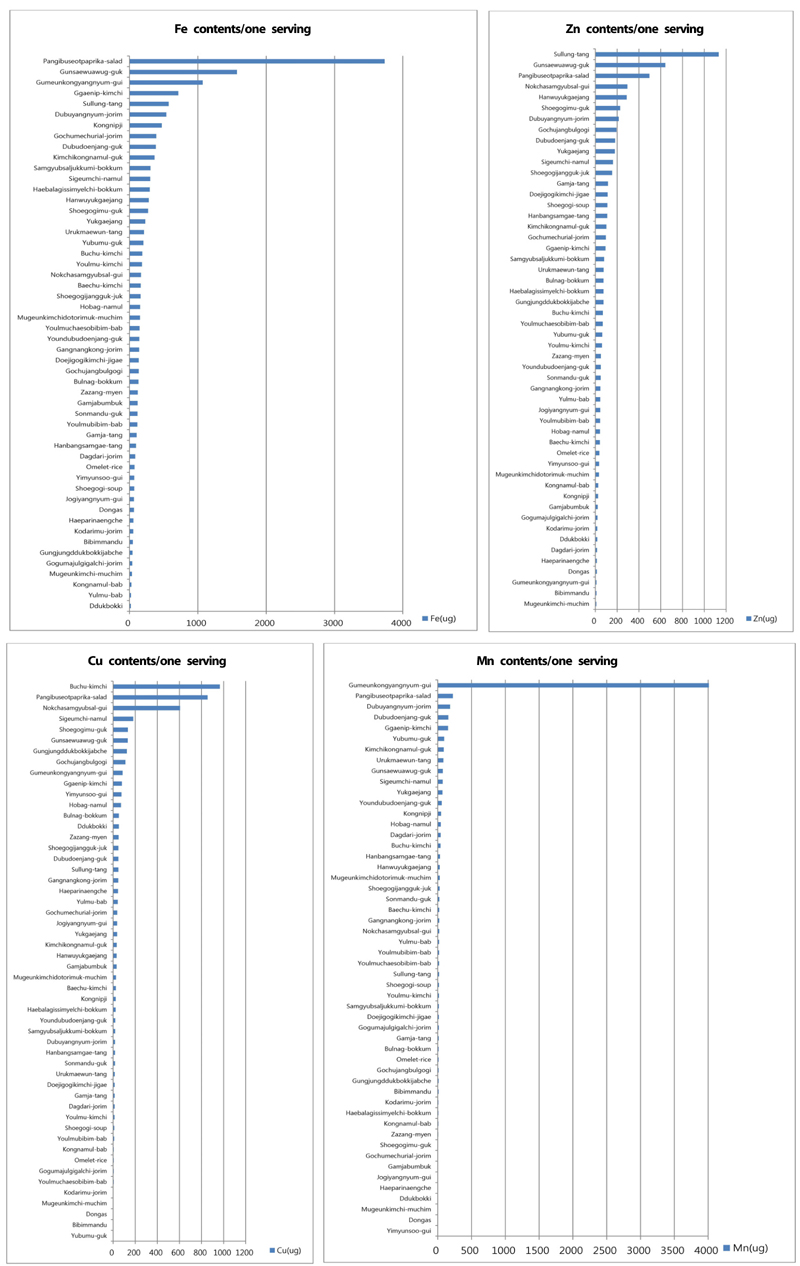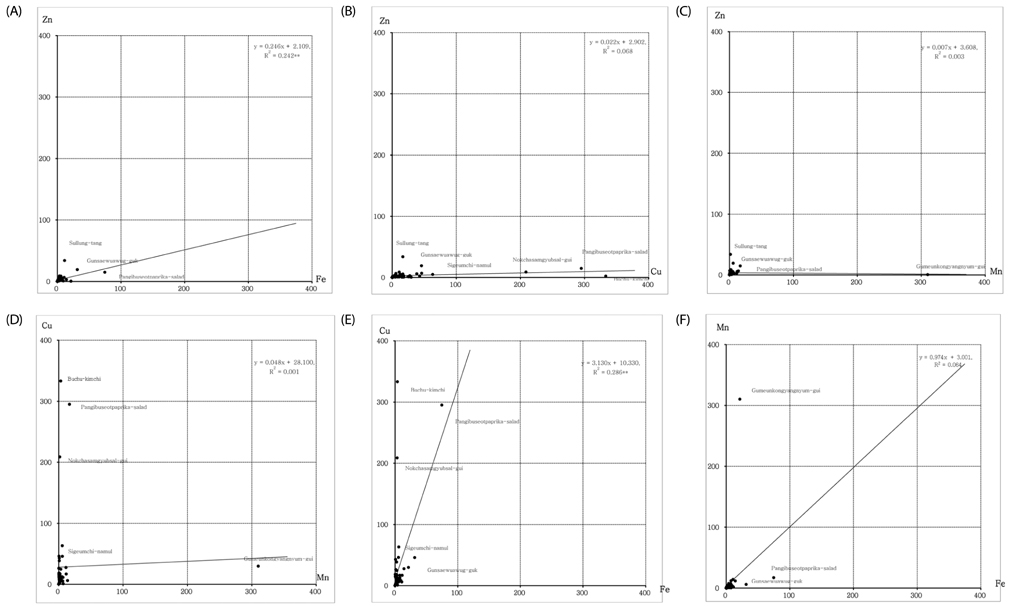Nutr Res Pract.
2014 Aug;8(4):439-444.
Analysis of micromineral contents of school meals
- Affiliations
-
- 1Department of Food and Nutritional Science, College of Natural Sciences, Kyungnam University, 7 Kyungnamdaehakro, Masanhappogu, Changwon, Gyeongnam Province 631-701, Korea. shinds@kyungnam.ac.kr
Abstract
- BACKGROUND/OBJECTIVES
Korean ordinary diets are referred to be good for human health in worldwide. However it is uncertain whether they provide microminerals enough for growth and health of teenagers. A main purpose of this study was to identify micromineral contents in school meals.
MATERIALS/METHODS
The fifty cuisines were collected from elementary schools and middle schools in Gyeongnam area. The contents of Fe, Zn, Cu and Mn among microminerals were analyzed by using ICP-OES method. Data were expressed as mean, standard deviation and range value and linear regression analysis performed.
RESULTS
Fe level of Pangibuseotpaprika-salad was the highest among side-dishes (average 346.6 microg) and Zn level of Sullung-tang was highest among soups (average 229.1 microg). Cu level of Buchu-kimchi was the highest among kimchies (average 217.5 microg) and Mn level of Gumeunkongyangnyum-gui was highest among side-dishes (average 198.4 microg). Generally cooked-rices as main dish had relative smaller amounts of microminerals than the other cuisines. The results showed that the ratio of Cu : Fe : Zn was approximately 12 : 4 : 1 and the relationship between Fe versus Zn or Fe versus Cu was significantly positive.
CONCLUSION
Comparing to Korean Dietary Recommended Intakes (KDRI) level, school meals provided not sufficient amount (<25% DRI) of Fe, Zn or Mn, while they did excessive amount (>125% DRI) of Cu.
Keyword
MeSH Terms
Figure
Reference
-
1. Oh MS, Uribarri J. Electrolytes, water, and acid-base balance. In : Shils ME, Shike M, Ross AC, Caballero B, Cousins RJ, editors. Modern Nutrition in Health and Disease. 10th ed. Philadelphia(PA): Lippincott Williams & Wilkins;2006. p. 149.2. Moreira DC, de Sá JS, Cerqueira IB, Oliveira AP, Morgano MA, Quintaes KD. Evaluation of iron, zinc, copper, manganese and selenium in oral hospital diets. Clin Nutr. Forthcoming 2013.
Article3. McArdle MA, Finucane OM, Connaughton RM, McMorrow AM, Roche HM. Mechanisms of obesity-induced inflammation and insulin resistance: insights into the emerging role of nutritional strategies. Front Endocrinol (Lausanne). 2013; 4:52.
Article4. Whitney EN, Cataldo CB, Rolfes SR. Understanding Normal and Clinical Nutrition. 6th ed. Belmont (CA): Wadsworth;2002.5. August D, Janghorbani M, Young VR. Determination of zinc and copper absorption at three dietary Zn-Cu ratios by using stable isotope methods in young adult and elderly subjects. Am J Clin Nutr. 1989; 50:1457–1463.
Article6. Solomons NW, Jacob RA. Studies on the bioavailability of zinc in humans: effects of heme and nonheme iron on the absorption of zinc. Am J Clin Nutr. 1981; 34:475–482.
Article7. Turnlund JR, Scott KC, Peiffer GL, Jang AM, Keyes WR, Keen CL, Sakanashi TM. Copper status of young men consuming a low-copper diet. Am J Clin Nutr. 1997; 65:72–78.
Article8. Finley JW. Manganese absorption and retention by young women is associated with serum ferritin concentration. Am J Clin Nutr. 1999; 70:37–43.
Article9. Feigin RD. Interaction of nutrition and infection: plans for future research. Am J Clin Nutr. 1977; 30:1553–1563.
Article10. Cunningham-Rundles S. Effects of nutritional status on immunological function. Am J Clin Nutr. 1982; 35:1202–1210.
Article11. Champagne CM. Magnesium in hypertension, cardiovascular disease, metabolic syndrome, and other conditions: a review. Nutr Clin Pract. 2008; 23:142–151.
Article12. de Oliveira Otto MC, Alonso A, Lee DH, Delclos GL, Jenny NS, Jiang R, Lima JA, Symanski E, Jacobs DR Jr, Nettleton JA. Dietary micronutrient intakes are associated with markers of inflammation but not with markers of subclinical atherosclerosis. J Nutr. 2011; 141:1508–1515.
Article13. Emanuela F, Grazia M, Marco de R, Maria Paola L, Giorgio F, Marco B. Inflammation as a link between obesity and metabolic syndrome. J Nutr Metab. 2012; 2012:476380.
Article14. Aljada A, Mohanty P, Ghanim H, Abdo T, Tripathy D, Chaudhuri A, Dandona P. Increase in intranuclear nuclear factor κB and decrease in inhibitor κB in mononuclear cells after a mixed meal: evidence for a proinflammatory effect. Am J Clin Nutr. 2004; 79:682–690.
Article15. Wellen KE, Hotamisligil GS. Inflammation, stress, and diabetes. J Clin Invest. 2005; 115:1111–1119.
Article16. Hatada EN, Krappmann D, Scheidereit C. NF-κB and the innate immune response. Curr Opin Immunol. 2000; 12:52–58.17. Fleet JC, Replogle R, Salt DE. Systems genetics of mineral metabolism. J Nutr. 2011; 141:520–525.
Article18. Gropper SS, Smith JL, Groff JL. Microminetals. In : Gropper SS, Smith JL, Groff JL, editors. Advanced Nutrition and Human Metabolism. 5th ed. Belmont (CA): Wadsworth/Cengage Learning;2009. p. 469–525.19. Wardlaw GM, Hampl JS, DiSilvestro RA. Trace minerals. In : Wardlaw GM, Hampl JS, DiSilvestro RA, editors. Perspectives in Nutrition. 6th ed. New York (NY): McGrawHill;2004. p. 413–444.20. de Oliveira Otto MC, Alonso A, Lee DH, Delclos GL, Jenny NS, Jiang R, Lima JA, Symanski E, Jacobs DR Jr, Nettleton JA. Dietary micronutrient intakes are associated with markers of inflammation but not with markers of subclinical atherosclerosis. J Nutr. 2011; 141:1508–1515.
Article21. Lönnerdal B. Dietary factors influencing zinc absorption. J Nutr. 2000; 130:1378S–1383S.22. Harvey LJ, McArdle HJ. Biomarkers of copper status: a brief update. Br J Nutr. 2008; 99:Suppl 3. S10–S13.
Article
- Full Text Links
- Actions
-
Cited
- CITED
-
- Close
- Share
- Similar articles
-
- Analysis of dietary insoluble and soluble fiber contents in school meal
- A Study on the School Lunch Program Served by the Elementary Schools in Muan: An Analysis of Nutrients and Diversity of Menu
- Gastroesophageal Acid Reflux According to Different Meals: Cheeseburger vs. Laver-rolled Rice
- Comparison of sodium content of workplace and homemade meals through chemical analysis and salinity measurements
- Analysis of sodium content of representative Korean foods high in sodium from home meal, foodservice, and restaurants




